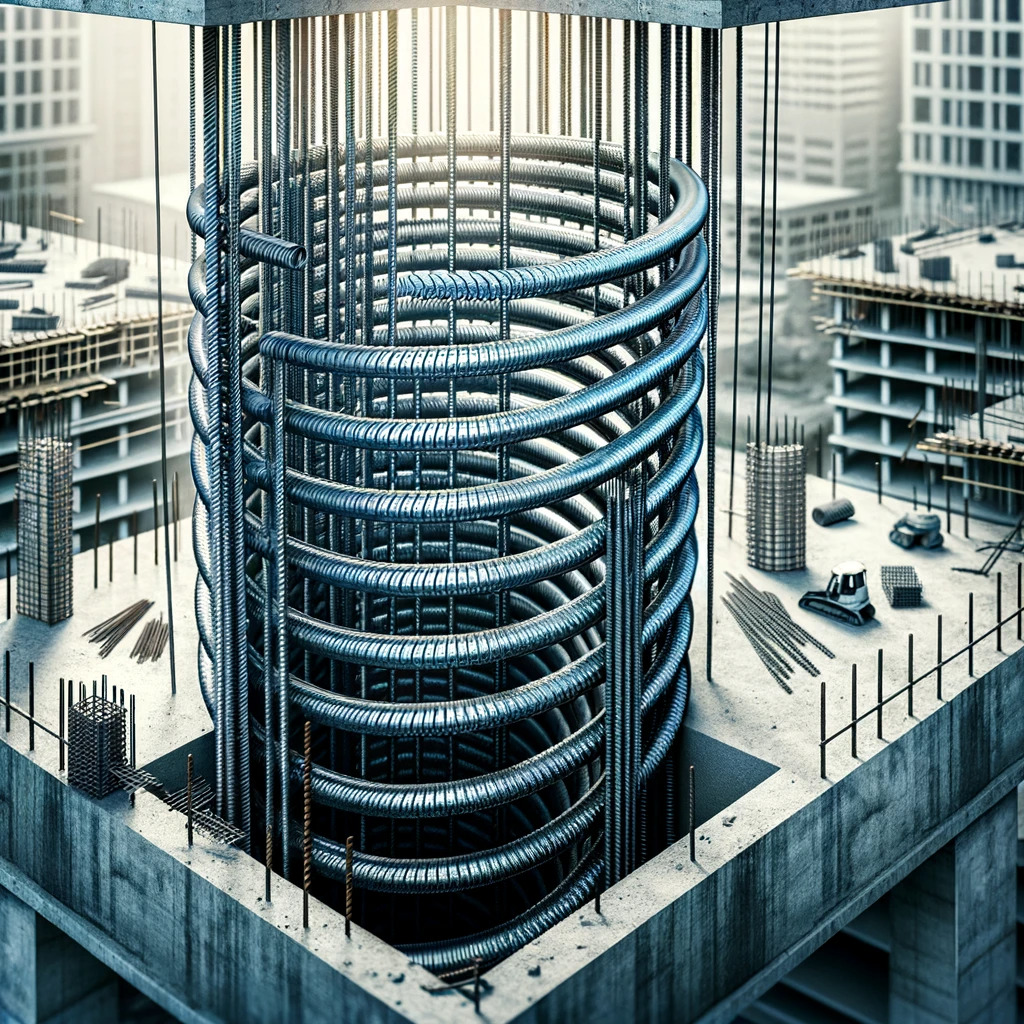Reinforcements play a vital role in enhancing the structural capacity of concrete structures by providing tensile strength to concrete members as concrete is weak in tension while much stronger in compression.
Along with the main longitudinal steel, transverse steel is also provided in RCC (Reinforced Cement Concrete) members. While transverse steel is termed as stirrups in case of beams, for columns it is referred to as:
- Lateral Ties
- Spiral Reinforcement or Helical Reinforcement
Table of Contents
Spiral Reinforcement
Spiral reinforcement is provided in a column to provide ductility, sustain maximum loads at extreme deformations and controls the lateral expansion of concrete.
Notice how in case of spiral reinforcements, due to increased ductility the reinforcement absorbed and dissipated large amount of energy before column failure. However, in case of column with lateral ties, there is significantly less deformation seen even when the column has failed.
Furthermore, it increases the load-carrying capacity of a column by providing confinement to the inner core of the column; confinement is provided to the inner core until the spiral reinforcement yields, afterwards the concrete core fails at excessive deformations.
Spiral Reinforcement is also a crucial element in construction of structures in seismic zones.
Types of spiral columns
There are three types of spiral columns (columns with spiral reinforcement):
Light Spiral
As the name refers, less transverse steel is required and this type is generally used in areas of less seismic activity.
ACI Spiral (Balanced Spiral)
For this type of transverse reinforcement steel is provided such that a balance is attained between ductility and strength for resistance against earthquakes. It is used where there is medium seismic activity.
Heavy Spiral
As the name suggests, maximum amount of spiral reinforcement is used as it is used for construction in high seismic activity areas.
While spiral reinforcement enhances the load-bearing capacity and as such, there are still a few drawbacks for this type of transverse reinforcement, such as:
- Required skilled labor as its installation is quite complex.
- Makes the formwork more complex.
- Limited code guidance for spiral reinforcement.
Difference Between Helical And Spiral Reinforcement
Generally, these two terms are often used interchangeably, however it is important to consider a minor difference between the two terms.
Helical reinforcement is a continuous circular reinforcement that is provided as transverse reinforcement it columns. It provides more confinement of inner concrete core comparatively.
Due to the superior load bearing capacity provided by the helical reinforcement, it is mostly favored in pile construction as well.
On the other hand, spiral reinforcement is provided as a non-continuous circular reinforcement around longitudinal bars placed in a circular manner in a column.
Both, helical and spiral reinforcements, have the same primary functions however they may be used as per the engineering requirements.
Difference Between Spiral Reinforcement And Lateral Ties
Both of these are used in columns around the longitudinal reinforcements in order to hold the bars in place and to provide stability.
Figure 5: Cross-section of a rectangular column with a lateral tie around 4- bars
Figure 6: Cross-section of a spiral column with spiral reinforcements around six longitudinal bars
- The main difference between the two transverse reinforcements is about their configuration.
- Spiral reinforcement increases the ductility of column as well as provides resistance against buckling while lateral ties only provide stability against buckling of the column.
- Spiral reinforcement are used in structures in earthquake prone areas whereas, lateral ties are used in conventional construction.
- According to ACI 318, the total strength reduction factor for spiral columns is “φ = 0.85 x 0.75” while, for tied columns (columns with lateral ties) the strength reduction factor is “φ = 0.80 x 0.65”.
Figure 7: Difference in Performance of Spiral Reinforcement and Lateral Ties
Codes And Standards
The limitations and design considerations for Spiral Reinforced Columns are provided by American Concrete Institute (ACI 318-19(22)) and International Building Code (IBC).
Limitations And Considerations As Per Aci-318
When spiral reinforcements are used in columns it is vital to keep the following in mind:
- At least six longitudinal (main bars) are to be provided when spiral reinforcement is to be used.
- Since spiral reinforcement provides increased splitting resistance therefore, the code allows us to reduce the splice length in compression.
- In multi-story buildings, for the purpose of lateral support of main bars provided by spiral reinforcement, the bottom of spiral should be at the top of footing or slab for any story level. And the top of spiral should be positioned in accordance to the following table:
Terms Related To Design Of Spiral Reinforcement
Clear Pitch
The clear distance between the adjacent faces of two consecutive spirals.
Pitch
Center-to-center distance between two consecutive spirals.
In reference to the above figure;
Dc = Diameter of the core of concrete column
dsp = Diameter of spiral reinforcement
Core of Column
It is the main load bearing component of a column that is surrounded by reinforcement, as illustrated in figure 4.
Diameter of Core
It is the center-to-center distance between the spirals as shown in figure 4.
DESIGN OF SPIRAL REINFORCEMENT
- Diameter of spiral bar should not exceed 10mm.
- Smin (minimum clear pitch) = larger of
- 4/3 of maximum aggregate size
- 25 mm
- Clear pitch maximum = not larger than 75 mm

Where,
fc’ = 28-days compressive strength of concrete cylinder
fy= yield strength of concrete
Ag= Gross Area
Ac= Area of concrete
In conclusion, spiral reinforcement should be used in seismic-prone areas and where there are high strength requirements instead of lateral ties as they provide ample warning before failing while enhancing strength of column core. The design of this reinforcement should be according to the guidelines provided by the code.





